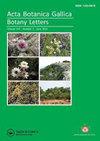A practical guide to quantifying the effect of genes underlying adaptation in a mixed genomics and evolutionary ecology approach
引用次数: 7
Abstract
Abstract In adaptation studies, approaches in genomics investigate the genetic, cellular and biochemical mechanisms involved in adaptation using model organisms. In study systems such as Arabidopsis, the demand is high to test for the effect of genes which polymorphism is known on the ability of plants to cope with adverse environmental conditions. In evolutionary ecology, understanding how selection and environmental heterogeneity shape the diversity of organisms is crucial. In that regard, tools to decipher how the architecture of standing genetic variation affects the evolutionary potential of plants to adapt are required. Quantitative genetics provide a range of statistical methods that could be used to study those questions but are generally neglected as a consequence of their scary name, as for example for the pedigree based random regression method used in our approach. Here, we provide a practical guide for researchers from multiple domains who would like to use such methods. We begin by providing an overview of some of the challenges in plant sciences, such as understanding the role of regulatory genes in adaptation that could gain from using such approach. We then illustrate the “how to” of the method by applying it to an imaginary example. We also provide a complete tutorial in the supplementary online material under the form of a protocol and data that can be used to train researchers and students by replicating entirely our approach. We conclude by highlighting the advantages and limits of such approach.在混合基因组学和进化生态学方法中量化基因潜在适应效应的实用指南
在适应研究中,基因组学研究了利用模式生物进行适应的遗传、细胞和生化机制。在拟南芥等研究系统中,检测基因多态性对植物应对不利环境条件能力的影响的需求很高。在进化生态学中,理解选择和环境异质性如何塑造生物体的多样性是至关重要的。在这方面,需要一些工具来破译现存遗传变异的结构是如何影响植物适应的进化潜力的。定量遗传学提供了一系列统计方法,可用于研究这些问题,但由于其可怕的名字而通常被忽视,例如我们方法中使用的基于系谱的随机回归方法。在这里,我们为希望使用这些方法的多个领域的研究人员提供实用指南。我们首先概述了植物科学中的一些挑战,例如理解调控基因在适应中的作用,这可能会从使用这种方法中获益。然后,我们通过将其应用于一个虚构的例子来说明该方法的“如何”。我们还以协议和数据的形式在补充在线材料中提供完整的教程,可用于通过完全复制我们的方法来培训研究人员和学生。最后,我们强调了这种方法的优点和局限性。
本文章由计算机程序翻译,如有差异,请以英文原文为准。
求助全文
约1分钟内获得全文
求助全文

 求助内容:
求助内容: 应助结果提醒方式:
应助结果提醒方式:


